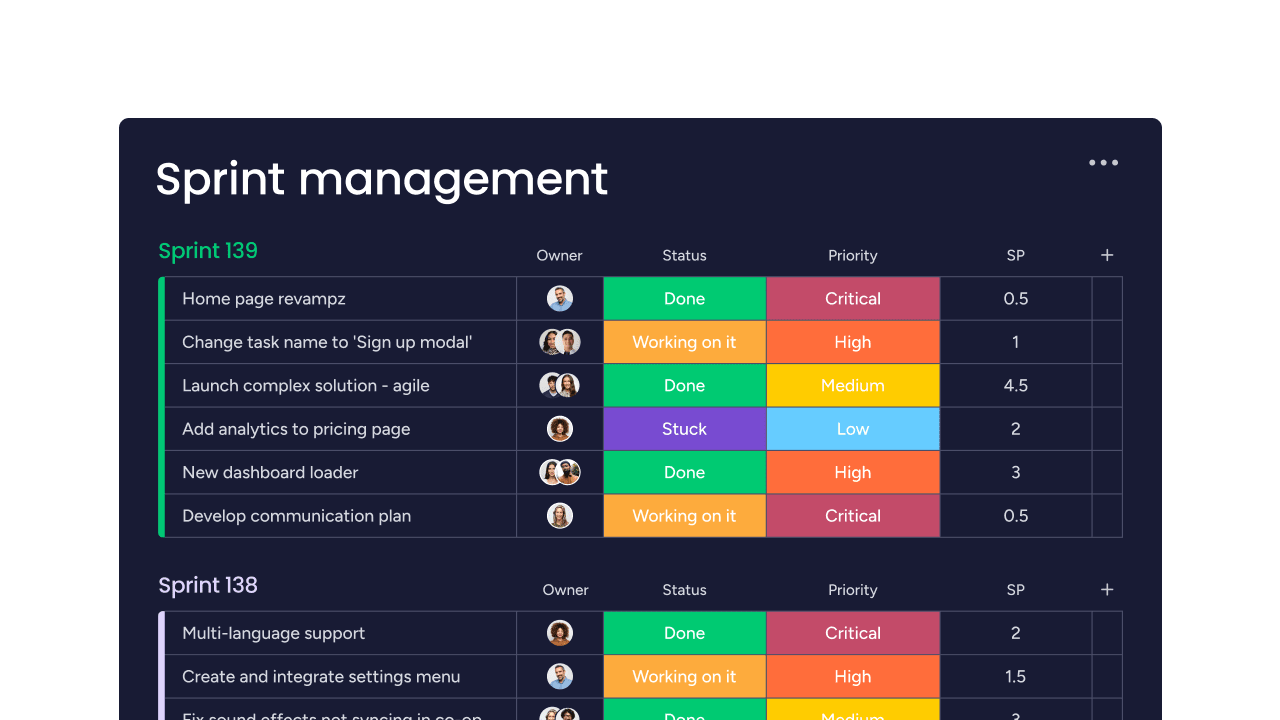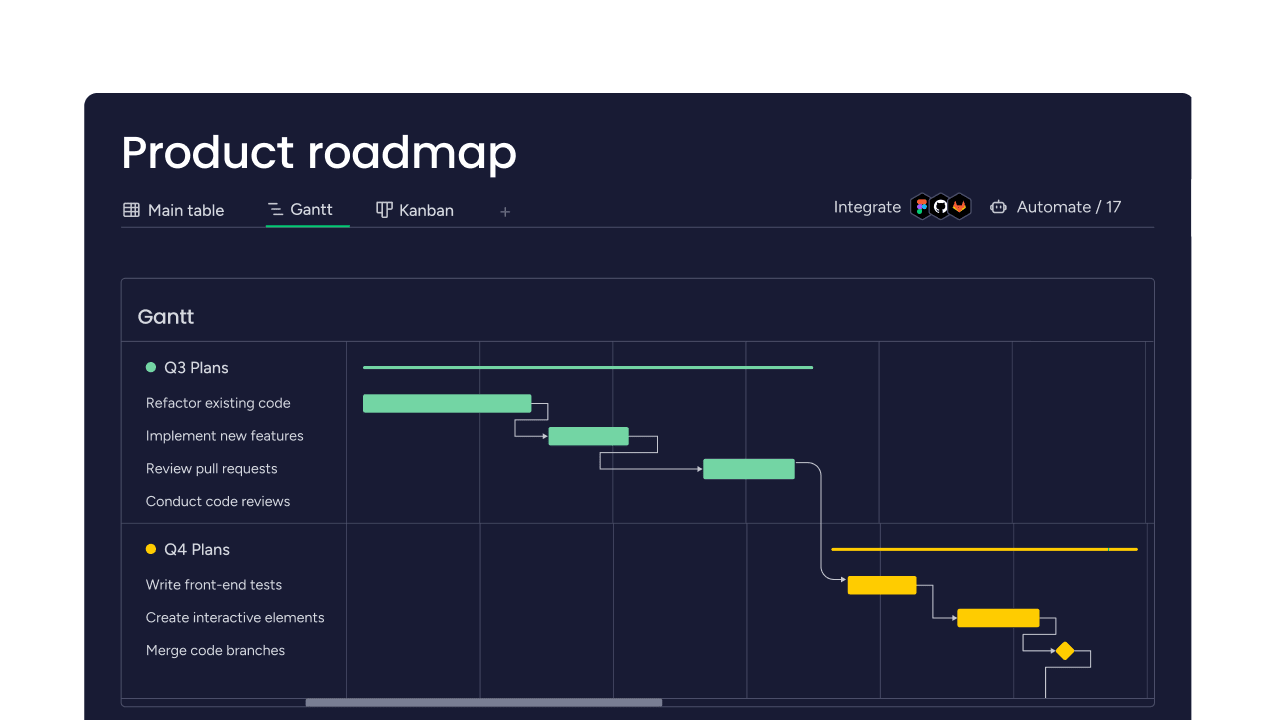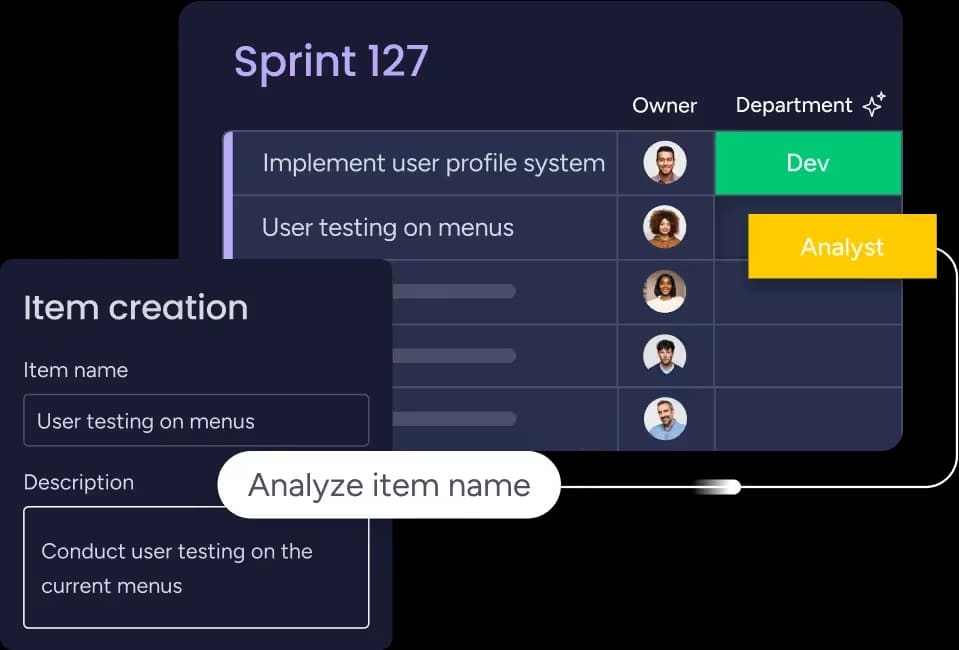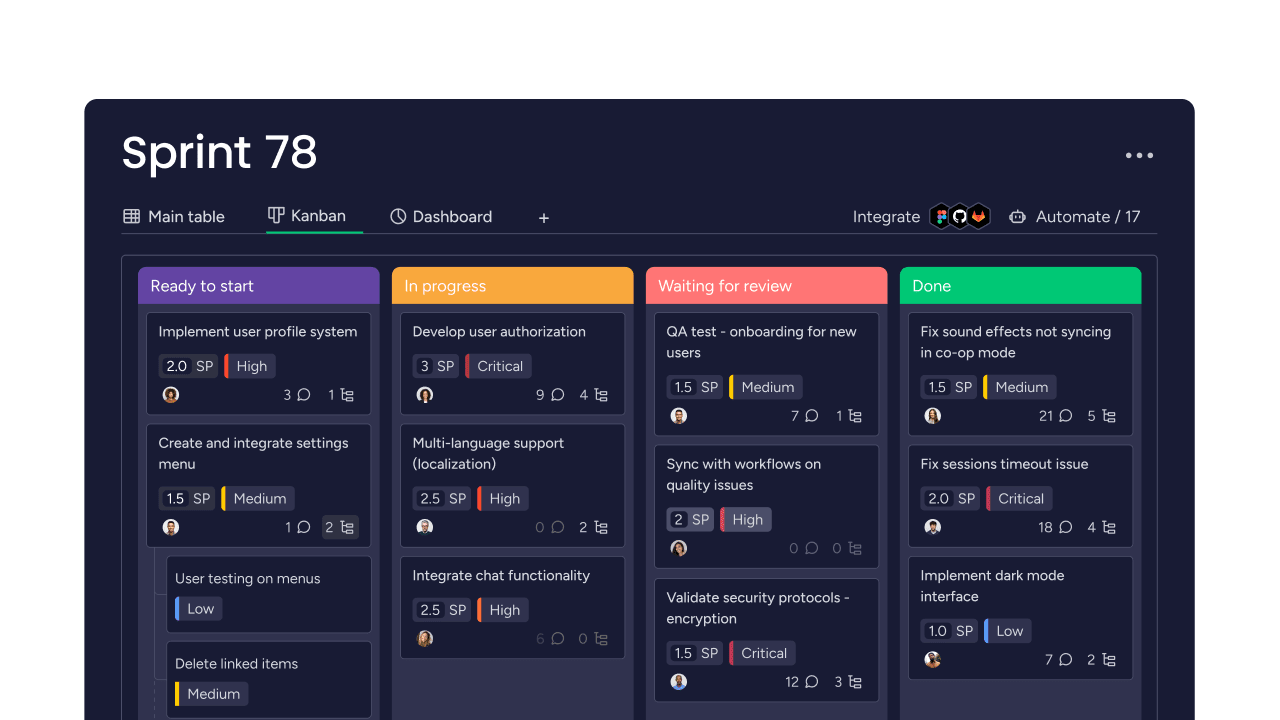Software development used to follow a predictable path, with projects planned months in advance. Today, it is a constant cycle of building, testing, and adapting to new information. When priorities shift and dependencies cross teams, informal methods break down, leaving teams reacting to problems instead of building great products.
This comprehensive article discusses the core principles of project management in software engineering, exploring the key stages of a project lifecycle from initial planning to final deployment. We will also cover different software development methodologies, essential team roles, and share how to build workflows that support rather than slow down development teams.
Mastering these practices helps align engineering with business goals, reduce risk, and accelerate delivery. It transforms development from a chaotic process into a predictable engine for growth.
Key takeaways
- Flexible project management adapts to unique team workflows: platforms that offer adaptable workflows, such as monday dev, allow software teams to customize processes rather than conforming to rigid structures.
- Success extends beyond schedule adherence: track business value, team health, and customer satisfaction to build software people actually want. Focus on outcomes that matter to users and stakeholders, not just delivery dates.
- Real-time visibility bridges engineering and business: transparent communication and shared dashboards enable faster decisions and build trust naturally. When everyone sees progress clearly, alignment happens without constant meetings.
- Customizable workflows support distributed collaboration: platforms like monday dev provide seamless integrations and flexible boards that let dev teams work their way while keeping stakeholders informed.
- Asynchronous collaboration enables global teams: remote and distributed teams succeed with clear handoff processes and robust documentation. The right platform makes geography irrelevant to great software delivery.
What is project management in software engineering?
Project management in software engineering is the practice of planning, organizing, and overseeing software development projects to deliver working solutions on time and within budget. It coordinates developers, designers, testers, and stakeholders through structured processes that balance technical complexity with changing requirements.
Software projects need specialized management because they involve constant change, deep technical dependencies, and frequent uncertainty. Teams must adapt to new information while managing competing priorities and technical debt.
Core components of software project management
Software project management relies on several key activities that keep teams aligned and productive. These components transform business requirements into working software while managing complexity and change.
Requirements gathering and analysis
Requirements gathering translates business needs into clear technical specifications. This process ensures everyone understands what the software should accomplish.
Teams document functional requirements, technical constraints, and success criteria. This collaboration between business, product, and engineering prevents costly misunderstandings.
Sprint planning and iteration management
Sprint planning divides work into manageable cycles with specific deliverables. Teams estimate effort, identify dependencies, and commit to realistic goals for each iteration.
This structure enables regular feedback and faster delivery of usable features. monday dev supports sprint planning with customizable boards that visualize dependencies and track progress.
Resource allocation and team coordination
Resource allocation assigns developers to work based on skills and availability. Clear coordination prevents bottlenecks and ensures efficient use of team members’ time.
Teams need visibility into who’s working on what and how different work streams connect. This awareness helps sequence work logically and identify conflicts early.
Risk assessment and mitigation
Risk assessment identifies potential problems before they derail progress. Teams evaluate technical debt, scope creep, and integration challenges, then develop strategies to reduce their impact.
Regular risk reviews help teams stay ahead of problems rather than constantly reacting to crises. This builds stakeholder confidence and enables accurate delivery forecasts.
Quality assurance and testing oversight
Quality assurance ensures software meets standards before deployment. Testing processes catch defects early when they’re less expensive to fix.
Teams coordinate different types of validation:
- Unit tests: verify individual components work correctly.
- Integration tests: ensure different parts work together.
- User acceptance tests: confirm the software meets business needs.
Stakeholder communication
Stakeholder communication keeps business teams informed through regular updates and transparent reporting. Teams tailor their communication style to different audiences.
Clear communication prevents misalignment between technical teams and business stakeholders. This ongoing dialogue ensures development efforts support business strategy.
Why software teams need structured project management
Modern software development has become too complex for informal approaches. Without structure, teams face costly delays, miscommunication, and misalignment that impact time-to-market and product quality. Structured project management provides three critical advantages:
- Accelerating delivery and market response: structured project management enables effective planning and prioritization. Teams align on clear roadmaps and visualize dependencies across work streams. Visual boards highlight bottlenecks in real time, enabling quick resolution. monday dev provides these visual workflows with automation that keeps work flowing smoothly.
- Reducing risk and improving quality: project management identifies risks like scope creep and technical debt before they become critical. Structured testing phases catch defects early, while quality gates ensure only production-ready code reaches customers.
- Aligning engineering with business strategy: project management bridges the gap between technical teams and business stakeholders, translating business requirements into actionable work items. A 2024 Harvard Business Review study found that 70% of software development teams using structured frameworks reported improved alignment, resulting in a 25% reduction in project delivery delays. Real-time dashboards provide visibility without constant status meetings.
The 5 stages of software project management
Software project management follows five stages that adapt to various methodologies. Understanding these stages helps teams maintain consistency while staying flexible.
Step 1: project initiation and scope definition
Project initiation defines what you’re building and why it matters. Teams gather requirements, identify stakeholders, and assess feasibility.
Clear scope definition prevents misunderstandings. Teams document what’s included and what’s explicitly out of scope to manage expectations.
Stage 2: strategic planning and resource allocation
Strategic planning involves technical architecture decisions, team assignments, and timeline estimates. Features get broken down into manageable work items with dependencies identified.
Visual planning helps spot resource conflicts and balance workloads. Platforms like monday dev offer customizable workflows that support this planning by visualizing dependencies and tracking capacity.
Stage 3: development execution and tracking
Development execution is where teams build, test, and refine software. Sprint management and daily standups maintain momentum and address blockers.
Real-time dashboards keep stakeholders informed without micromanagement. Developers focus on building while managers maintain visibility into progress.
Stage 4: testing and quality management
Quality management ensures software meets standards before release. Teams coordinate testing to catch defects early in development.
Bug tracking and performance validation prevent quality issues that could impact users. Teams establish clear quality criteria and don’t proceed until software meets those standards.
Stage 5: deployment and continuous improvement
Deployment releases software to production and monitors performance. Teams gather user feedback and plan future iterations based on real usage.
Retrospectives ensure each project cycle builds on lessons learned. Teams identify what worked well and what to change going forward.

Key roles in software project management
Clear roles prevent confusion and delays. When everyone understands their responsibilities, teams move faster and make decisions more effectively.
The modern software project manager
The modern project manager facilitates rather than commands. They remove blockers, enable communication, and maintain project visibility.
Key responsibilities include:
- Stakeholder management: coordinate diverse interests without overwhelming developers.
- Risk assessment: identify problems early and develop mitigation strategies.
- Process optimization: establish clear processes that enable rather than constrain.
Development team structure and leadership
Software teams include various specialized roles working together to deliver features. Each contributes specific expertise while collaborating closely with others.
Team roles and their focus areas:
- Tech leads: guide technical decisions and mentor team members.
- Senior developers: own complex features and support code reviews.
- QA specialists: ensure quality through comprehensive testing.
- DevOps engineers: automate deployments and monitor system health.
- Architects: define system design and technical direction.
Stakeholder management across departments
Software projects involve stakeholders from product, marketing, sales, and support. Project managers coordinate these interests to maintain alignment.
Effective stakeholder management ensures all voices are heard without overwhelming the development team. This balance keeps teams focused while maintaining business alignment.
Selecting the right methodology for your team
Different methodologies suit different contexts, and no single approach works for every team or project. The right choice supports team strengths and project requirements while aligning with organizational culture and stakeholder expectations.
Agile and Scrum for iterative development
Agile prioritizes adaptability and frequent feedback over rigid planning. It works best for projects with changing requirements and experienced teams. According to a 2022 McKinsey report, software projects that use agile project management practices are 1.5 times more likely to succeed than those using traditional waterfall methods, with agile teams reporting a 30% faster time-to-market.
Scrum ceremonies provide structure:
- Sprint planning: define work for the upcoming iteration.
- Daily standups: coordinate and identify blockers.
- Retrospectives: improve processes based on experience.
Advanced platforms like monday dev support Agile with sprint boards and burndown charts that adapt to how teams work.
Waterfall for compliance and structure
Waterfall follows a sequential approach where each phase completes before the next begins. It suits projects with fixed scope and regulatory requirements.
This approach emphasizes documentation and formal approvals. It works well where compliance dictates strict processes and changes are expensive.
Hybrid approaches for complex environments
Hybrid methodologies combine Agile and Waterfall elements. Teams might use Waterfall for planning and compliance, then switch to Agile for development.
This pragmatic approach acknowledges that pure methodologies rarely fit real situations perfectly. The key is being intentional about which elements to adopt.

How to build workflows that adapt and scale
Rigid processes hinder teams as they grow. You need workflows that maintain efficiency while adapting to changing needs. The best project management approaches provide structure without constraint, enabling teams to scale smoothly.
Customizing processes without compromising standards
Teams can tailor workflows while maintaining quality standards. Customizable elements include approval processes, testing requirements, and deployment procedures.
Modern solutions like monday dev provide this flexibility through customizable workflows. Teams design processes that match how they work rather than forcing work into predetermined templates.
Automation strategies for development teams
Automation reduces manual overhead and human error. Strategic automation focuses on high-value opportunities that free teams for creative work.
Key automation opportunities:
- Task creation: automatically generate tasks from pull requests.
- Status updates: update boards when code merges.
- Notifications: alert teams when dependencies resolve.
Managing change in fast-moving projects
Change is normal in software development. Effective change management balances flexibility with stability.
Regular backlog grooming and transparent communication help teams adapt quickly. Clear documentation ensures everyone stays aligned despite shifting priorities.
AI and analytics in project management
AI transforms project management from reactive to predictive. These technologies provide actionable insights and intelligent automation that help teams stay ahead of challenges:
- Predictive timeline and cost estimation: AI analyzes historical data to improve estimation accuracy. Machine learning identifies patterns in velocity, bug rates, and scope changes, helping teams set realistic expectations and spot delays early. Teams can adjust plans based on data rather than optimistic guesses.
- Automated resource and workload optimization: AI optimizes team assignments by analyzing skills and availability. Automated workload balancing prevents burnout and maximizes productivity. Resource conflicts get identified in advance with AI suggesting alternatives, addressing inefficiencies that slow execution and increase costs.
- Data-driven risk management: analytics detect project risks by identifying failure patterns. Early detection of scope creep and technical debt allows proactive responses. Enhanced visibility prevents delivery failures and quality issues, enabling teams to address problems while they’re still manageable.

Achieving visibility without disrupting flow
Effective project management provides visibility without micromanaging developers. The right approach maintains autonomy while keeping everyone informed.
Real-time dashboards for every stakeholder
Different stakeholders need different views of progress. Executives need business outcomes, managers need detailed tracking, developers need task views.
Modern solutions like monday dev offer role-based dashboards tailored to each audience. Teams customize views without overwhelming anyone with irrelevant details.
Team health and performance monitoring
Key indicators reveal team health and process effectiveness:
- Velocity trends: show if teams are speeding up or slowing down.
- Cycle time: measures how long work takes to complete.
- Workload distribution: identifies if some team members are overloaded.
Transparent communication without micromanagement
Automated updates and milestone reporting enable timely interventions only when needed. This builds trust and reduces constant check-ins.
Teams focus on execution rather than reporting. Stakeholders maintain confidence that work progresses as planned.
How to manage distributed and remote teams
Remote development teams face unique coordination challenges. Successful distributed teams use specialized practices for asynchronous collaboration.
Implementing follow-the-sun development
Follow-the-sun development enables continuous progress across time zones. Effective handoffs and thorough documentation maintain quality despite lack of real-time collaboration.
Platforms supporting seamless handoffs ensure work continues smoothly. This approach can dramatically accelerate delivery when implemented effectively.
Asynchronous collaboration best practices
Asynchronous communication is essential when real-time meetings across time zones are impractical. Documentation standards and decision logs support team cohesion.
Effective async practices:
- Recorded demos: share progress without scheduling meetings.
- Decision logs: document choices and reasoning.
- Async standups: update status on your schedule.
Building culture across geographic boundaries
Distributed teams need intentional culture building. Virtual team activities and inclusive communication help everyone feel connected.
Leaders must create opportunities for connection. Remote team members should feel as included as those in headquarters.

Measuring success beyond schedule and budget
Traditional engineering metrics miss critical aspects of software success. Modern teams track broader indicators that capture business value and team health:
- Business value and ROI measurement: business impact gets measured through user adoption and revenue growth. ROI calculations connect technical deliverables to business outcomes, justifying continued investment. Teams demonstrating business impact build credibility with stakeholders.
- Team velocity and productivity tracking: velocity metrics track performance trends using story points and cycle time. These support planning without creating unhealthy pressure. Use metrics for learning rather than judgment; when teams feel safe discussing trends honestly, they can address real problems.
- Customer satisfaction and quality indicators: quality gets measured through bug rates and user feedback. Balancing speed with quality ensures teams deliver features users love. These indicators connect technical work to user outcomes, building software people actually want to use.
Choosing project management platforms for software teams
Platform choice significantly impacts team productivity. Rigid platforms create friction while flexible ones empower teams to adapt.
Evaluating features for development workflows
Critical platform features support modern development practices and natural workflows rather than forcing predetermined processes.
Essential capabilities:
- Integration: connect with Git, CI/CD pipelines, and other dev tools.
- Customization: adapt workflows to team needs.
- Real-time updates: support distributed collaboration.
- Analytics: enable data-driven decisions.
- Scalability: grow with your organization.
Migrating from legacy systems
Migration requires careful planning to minimize disruption. Phased rollouts and clear communication help teams understand changes.
Focus on user adoption rather than just technical implementation. The goal is improving how teams work.
Integration with your tech stack
Seamless integration eliminates silos and improves accuracy. APIs and pre-built connectors ensure platforms fit your tech ecosystem.
When systems communicate automatically, teams focus on building software rather than synchronizing data.

"monday dev empowered us to optimize our GTM approach, resulting in faster, more dependable deliveries"
Steven Hamrell | Director of Product Management
"monday dev empowers us to manage the entire development process on one platform so we can speed up product delivery and improve customer satisfaction"
Mitchel Hudson | Head of Technology
"We're operating in an open, deep trusting, transparent environment with no silos of information. It's about completely opening access to everyone who needs it."
Alan Schmoll | Executive Vice President, Vistra PlatformTransform your software project management with monday dev
Modern software teams face core challenges that slow delivery: inflexible platforms, poor visibility, and inefficient execution. These obstacles are addressed by monday dev, which empowers teams to work their way while connecting business and engineering seamlessly.
Flexibility to work your way
With customizable boards and automation, monday dev adapts to different workflows. Teams maintain preferred methodologies while gaining enhanced visibility.
The platform provides structure without rigidity. Teams establish consistent processes while preserving needed adaptability.
Powerful features built for development teams
Specialized capabilities from monday dev address the unique needs of software teams:
- Sprint management boards: visualize sprints with customizable views including Kanban, timeline, and Gantt charts that adapt to your workflow.
- Git integration: connect directly to GitHub, GitLab, and Bitbucket to sync pull requests, commits, and branches automatically.
- Bug tracking: capture, prioritize, and resolve issues with dedicated bug boards that link directly to your codebase.
- Roadmap planning: build visual product roadmaps that connect strategic initiatives to daily development work.
- Automated workflows: eliminate manual updates with triggers that move tasks, notify teams, and update statuses based on code events.
- Real-time dashboards: create role-specific views showing sprint progress, velocity trends, and team capacity at a glance.
- Code review management: track pull requests and code reviews directly within your project boards.
- CI/CD pipeline visibility: monitor build status, deployment progress, and release cycles without switching tools.
Seamless business and engineering connection
Shared dashboards and automated reporting bridge technical and business teams. This eliminates the translation layer between stakeholders.
Everyone accesses relevant information in real time. This transparency builds trust and enables faster decisions. Business stakeholders see progress in terms they understand, while developers maintain the technical detail they need.
Frequently asked questions
What are the 5 stages of software project management?
The five stages of software project management are project initiation and scope definition, strategic planning and resource allocation, development execution and tracking, testing and quality management, and deployment and continuous improvement. These stages provide structure while allowing flexibility for different methodologies.
How do I become a software project manager?
Becoming a software project manager typically requires technical understanding, project management skills, and relevant certifications like PMP or Scrum Master. Most professionals transition from development, business analysis, or traditional project management roles.
Which certifications help software project managers advance?
Key certifications include Project Management Professional (PMP), Certified Scrum Master (CSM), and Agile Certified Practitioner (PMI-ACP). These demonstrate expertise in both traditional project management and modern software methodologies.
How do distributed software teams handle project management?
Distributed teams manage projects through asynchronous communication tools, clear documentation standards, and follow-the-sun development practices. Success requires robust platforms providing real-time visibility and seamless handoffs between time zones.
What metrics matter most in software project management?
Important metrics include team velocity, cycle time, defect rates, and business value delivered. These provide insights into team health, product quality, and customer satisfaction beyond traditional schedule and budget constraints.
